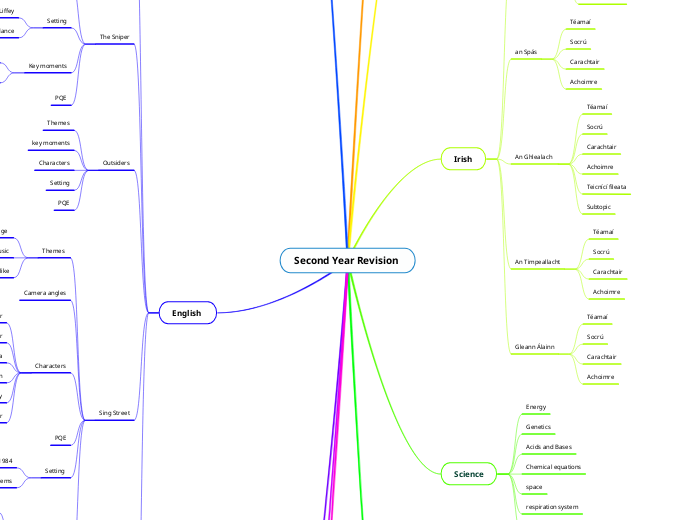Second Year Revision
History
Age of exploration
Causes
Aztec conquest
Incan Conquest
Consequences
Reformation
Causes
Martin Luther
Course
Consequences
1798 rebellion
Causes
Wolfe Tone
Course
Consequences
American Revolution
Causes
Course
Consequences
The Famine
Causes
Course
Consequences
Parliamentary Traditions of Ireland
Traditions
Daniel O' Connell
known as the great liberator
Catholic Emancipation
Charles Stuart Parnell
Leader of home rule party
GAA
Maths
Money
Currency
Currency exchange
Ways to exchange
Data
Types of Data
Ways to collect data
Algebra
Factorising
Expanding
Solving linear equations
To solve linear equations, you need to isolate the variable on one side of the equation. Here are the steps to follow:
1. Start by simplifying both sides of the equation if necessary, by combining like terms.
2. Use the properties of equality to get rid of any constants or coefficients attached to the variable. You can do this by performing the opposite operation (addition/subtraction or multiplication/division) on both sides of the equation.
3. Continue simplifying until you have the variable term alone on one side of the equation.
4. If the variable has a coefficient of 1, you can simply write the variable. If not, divide both sides of the equation by the coefficient to get the value of the variable.
5. Check your solution by substituting the value back into the original equation. If both sides of the equation are equal, then your solution is correct.
Remember to follow these steps carefully and perform the same operations on both sides of the equation to maintain equality.
Geometry
Angles
Irish
Jeaic ar scoil
Téamaí
Socrú
Carachtair
Achoimre
Teicnící fileata
an Spás
Téamaí
Socrú
Carachtair
Achoimre
An Ghlealach
Téamaí
Socrú
Carachtair
Achoimre
Teicnící fileata
Subtopic
An Timpeallacht
Téamaí
Socrú
Carachtair
Achoimre
Gleann Álainn
Téamaí
Socrú
Carachtair
Achoimre
Science
Energy
Genetics
Acids and Bases
Chemical equations
space
respiration system
Inheritance and variation
Religion
Morality
The Religious moral codes
Christianity
Parables
Teaching of Jesus in the Bible
Beatitudes
Islam
Five pillars of faith
Judaism
The ten commandments
Covenant
Hnduism
Karma
Dharma
Samsara
Moksha
five daily duties
Buddhism
eight fold path
A non-religious moral code
natural law theory
Belief in human life and thats all that exits
Philosophy
Socrates
Decision that impact your life choices
Influences on morality
Parents
natural law
Consiouseness
The law
Religion
media
Education
What is morality
Morality is about how we make decisions that influence our lives.
Sources of morality
Sources of authority
Conscience
Personal thinking
Personal experience
family and friends
religious tradition
religious principals of rites
sacred text
Founders of faith
Founders of faith
Judaism
Moral code
Founders
Sacred text
Place of wordship
Symbol
Christianity
Moral code
Founder
Sacred text
Place of wordship
Symbol
Art
Symbols
Types of art
Geography
Seas
erosion
Waves
How do waves erode
Hydraulic Action
Hydraulic action is the ability of moving water to dislodge and transport rock particles
Abrasion
The wearing down and grinding down of coasts
Compressed air
Solution
Attrition
Maharees coastal erosion
In 2016 maharees had the road blocked 19 times in the winter
Then they planted sand dunes and now they have raised 15 feet and put down fences
Fences stopped people from walking
Deposition
case studies
Key words
Hydraulic Action
Hydraulic action is the ability of moving water to dislodge and transport rock particles
Abrasion
The wearing down and grinding down of coasts
Attrition
Stones carried by the waves hitting off each other. Over time, they smoothed and worn down
Compressed air
Air in rocks becomes trapped by the incoming waves. The trapped air pressurises the rocks. When the water retreats, the air expands and pressure drops. This repeated compression and release causes rocks to shatter.
Solution
Certain rocks such as limestone dissolve in water
Sea Transportation
Protecting coasts - Coastal Management
Sea walls
Sea walls are walls that curved to push the waves back out into sea
Gabions
Steel wired cages filled with stones and are stacked on top of each other
Groynes
Concrete or wooden walls or fences that are bulit at the sea at right angles to reduce longshore drift
Soils
How it forms
Types of soil
Key words
Migration
Why people migrate
Key words
Organised Migration
Forced Migration
Self Migration
Population
Population Pyramid
Birth and death rates
Maps
Parts of a map
How to draw a map
Settlement patterns
Mass Movement
Tectonic plates
Earthquakes
Climate change
Paris 2025
Human interaction
Weather
Tropical Storms
Types
Case study
Weather
Instruments to measure
Glaciers
Glacier erosion
Glacier deposition
Moraine
How they form
Case study
Key words
Eratic
Plucked by glaciers and carried downhill
English
Dulce et Decorum
Poetic Techniques
Themes
Overview
Message
PQE
The Sniper
Themes
War
Family life
Setting
River Liffey
War of Independance
Key moments
Has the smoke to alert sniper
Informer comes
PQE
Outsiders
Themes
key moments
Characters
Setting
PQE
Sing Street
Themes
Coming of age
Music
A character I like
Camera angles
Characters
Conor Lawlor
Brendan Lawlor
Raphina
Eamonn
Barry
Br. Baxter
PQE
Setting
Dublin 1984
Socio economic problems
Key moments
First meeting with Raphina
Br. Baxter pushing Conor into the sink
Run away to England
Bands first meeting
Conor's American 50's vision
First Gig
Parents spilt up
Riddle of the Model video
Base details
Theme
Message
Setting
Poetic techniques
PQE
Business
World of Work
Labour force
Entrepreneur
Spotting a gap in the market
marketing
Budget
Circular flow of income
Demand and Supply
Industrial relations
Wages and salaries
Saving
TG
Orthographic projection
Developments
Logos
Pictorial Drawing
French
Ma Maison
les nombres
Months and days of the week
Les passe - temps
les temps
verbs
